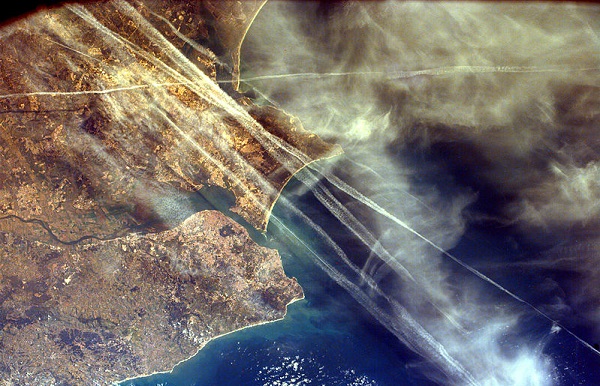Contrails might be a punch line in the culture these days, thanks to the imaginative folks who have rechristened them “chemtrails” and embroidered them with elaborate theories involving government and corporate misdeed.
But contrails are pretty serious business for a less conspiratorial reason: scientists believe these ice clouds generated by water exhaust gases from aircraft engines could have a real impact on the climate, perhaps by cooling temperatures during the day and warming them at night.

That’s where a new phase in an ongoing NASA study comes into play: The space agency recently began doing flights over the Southern California desert in which a DC-8 “flying laboratory” is testing the contrail consequences of using standard JP-8 jet fuel versus a 50-50 blend of JP-8 and a biofuel made from camelina plants.
“We believe this study will improve understanding of contrails formation and quantify potential benefits of renewable alternate fuels in terms of aviation’s impact on the environment,” said Ruben Del Rosario, manager of NASA’s Fixed Wing Project.
In its flights, the DC-8 is soaring to elevations as high as 40,000 feet, trailed all the while by a Falcon HU-25 equipped with “more than a dozen instruments” that can help the researchers understand the composition of the soot and gasses emitted by the DC-8 “and monitor the way exhaust plumes change in composition as they mix with air.” NASA said the Falcon will snuggle up to within 300 feet of the DC-8. It will also look for opportunities, weather and air traffic controllers permitting, to trail commercial aircraft, but in those cases the Falcon will be 10 miles in back.
According to the European Centre for Research and Advanced Training in Scientific Computing (CERFACS), “Contrails are ice clouds that form by condensation of water vapor exhaust from aircraft engines and develop further in the aircraft wake as they are entrained by the airplane trailing vortices.”
So what’s the problem with that? As CERFACS explains:
When contrails spread to form cirrus clouds, they can persist for hours and extend over areas of several square kilometers. These “contrail cirrus,” which artificially increase Earth’s cloudiness and become almost indistinguishable from natural cirrus, are among the most uncertain contributors to the Earth’s radiative forcing. (Radiative forcing is defined as the change of the net radiating flux resulting from changes in the atmospheric composition. A measure of the perturbation of Earth-atmosphere energy budgets, it is widely used as a climate metric).
NASA said its testing program, which began on Feb. 28, would last up to three weeks. A second phase of the flights, dubbed ACCESS – Alternative Fuel Effects on Contrails and Cruise Emissions – is planned for 2014 with “a more extensive set of measurements.”
It might be interesting to see if NASA will by then test a 100 percent biofuel mixture – Canadian researchers pulled off such a flight last fall and found “an important reduction in aerosol emissions (50 percent)” and “a significant reduction in particles (up to 25 percent) and in black carbon emissions (up to 49 percent) compared to conventional fuel.”